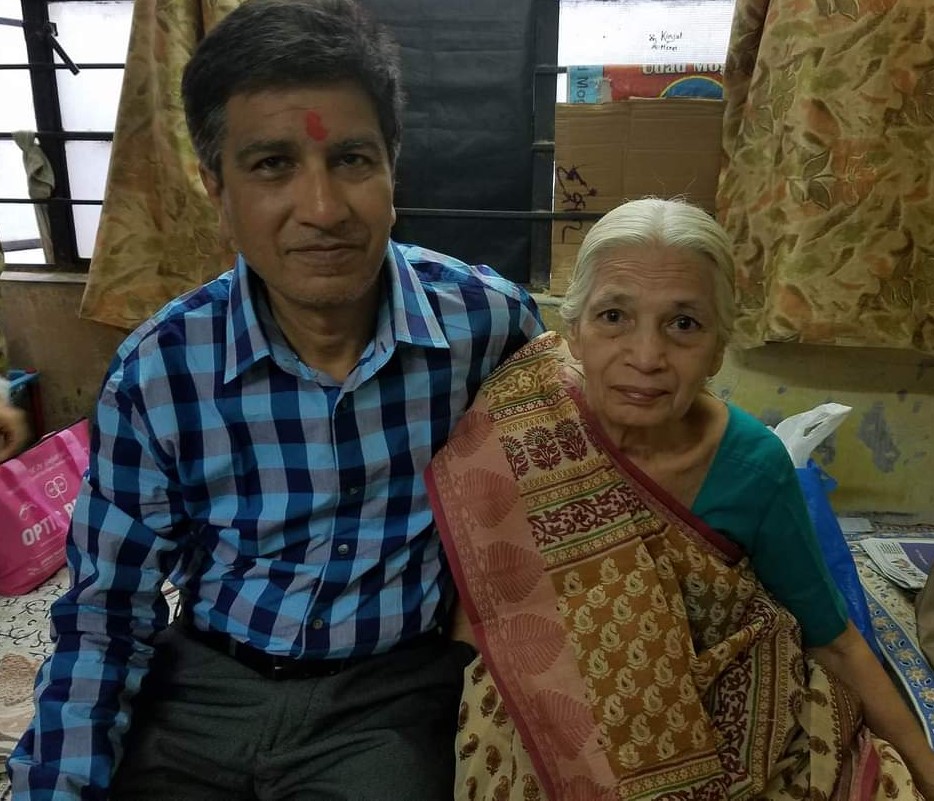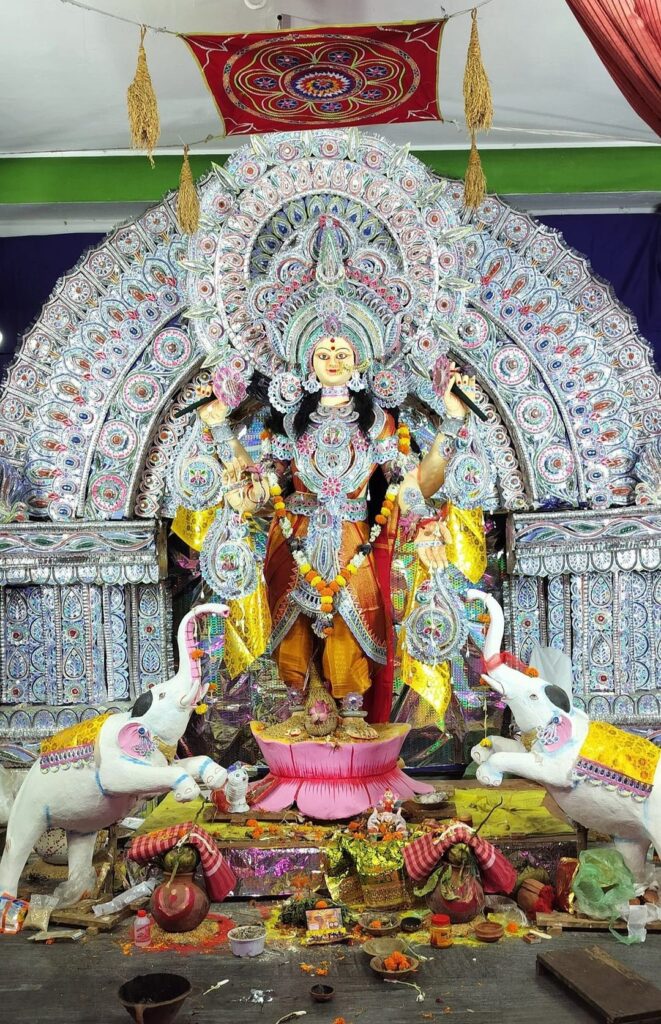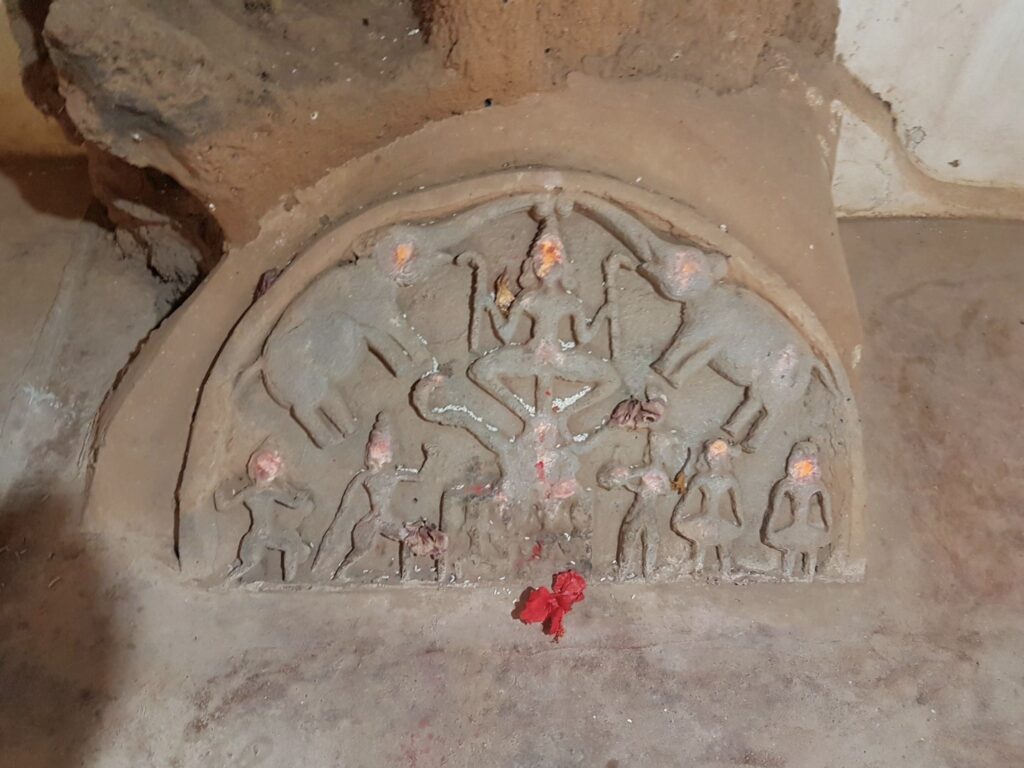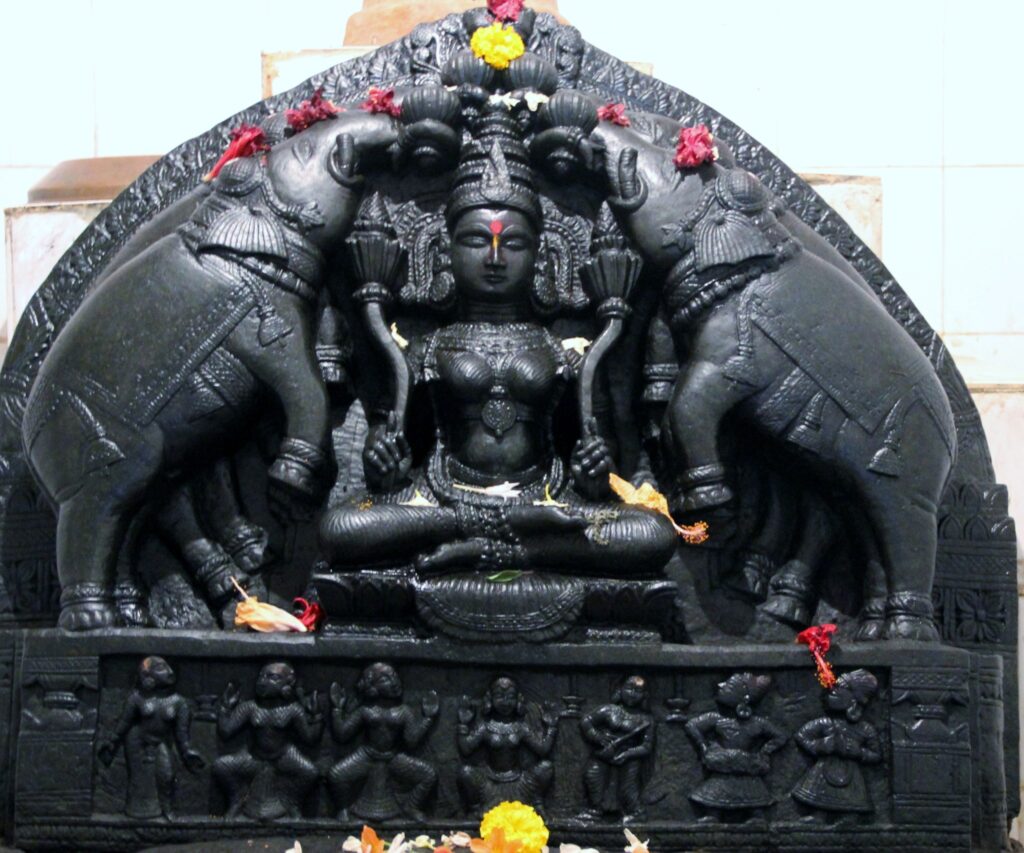Shri Alkesh Zaveri is Director of the USA Chapter of Heritage Foundation of Jalgaon. As a heritage lover, his main area of study is the imagery of Gajalakshmi across India. He has given talks on topics such as, – ‘The Unsung Lyrics of Hira and Teni’, ‘The Presiding Deity of Immense Opulence, Good fortune, Prosperity and Splendour – Sri Mahalakshmi’, ‘The Sacred Goddess Lakshmi and her veneration In Various Communities’,’Journey of Goddess Gaja-Lakshmi Through Millennia’, ‘The Neglected Archeological Site of Amjahra and Karhar Ma, Gajalakshmi and Her Connection with Elephants’.
In this interview he speaks about what inspired him to look at Gajalakshmi, and her significance in worship. She is seen as one among Ashtalakshmi, the eight primary forms of Lakshmi represented as the giver of power of royalty. Gajalakshmi is believed to have restored the wealth and power lost by Indra (king of gods) when she rose from the churning of the ocean. She has four arms, is garbed in red garments, carries two lotuses in two hands, while the other hands are in the abhaya-mudra and varada-mudra pose, and she is flanked by two elephants bathing her with water pots.
What made you choose the topic of Gajalakshmi and what inspires you towards this form of the Goddess?
Kamleshvari Devi situated in Bhinmal – Rajasthan is our kuladevi. With my mother Rajkumari Kalidas Zaveri being an ardent follower of Goddess Lakshmi along with my maternal and paternal family, we always prayed to Lakshmi. As a child I used to listen to her ideas about Lakshmi which she would communicate through various mythological stories. She would also explain the worldly significance of the story of Lakshmi associated with the mercantile community – Mangal Chandi ma – which is part of the poem “Chandimangala Kavya” where the Goddess is said to be playing with an elephant. The form Gajalakshmi itself means Lakshmi and Elephant.
(Figure 1: Shri. Alkesh Zaveri with his mother, with his mother Smt. Rajkumari Kalidas Zaveri )
Another version of the elephant and its connection with the Goddess is the story of Amarjal. This is related to the Vindhya Vasini triangle – where goddess Lakshmi (Mother Earth) does penance to save the creatures of the Earth and elephants bathe her (giving her lustre) with water forming the motif of “Abhishek Gajalakshmi” (the concept of Rain and Earth). This attracted me to collect her various pictures and inspired me to know more about her and so I focused on the Gajalakshmi form of Goddess – which is mother Goddess after the Lajja Gauri form. Today, I have collected over 4000 images of Gajalakshmi.
One of the eight primary forms of Lakshmi (Ashtalakshmi) represented as the giver of power of royalty, she is depicted with four arms. She is believed to be one of the earliest forms worshiped of the Feminine Divine. What information do we have about the antiquity of her worship?
The Gaja-Lakshmi form is a form of Goddess Lakshmi with one or more than one Elephant. The word Lakshmi itself signifies a sign of beauty, the mark of royal power, luck, prosperity, grace, happiness, royal domain and good fortune.Usually Lakshmi appears in eight forms namely,
- Adi Lakshmi with creative power,
- Vidya Lakshmi with power of learning.
- Santaana Lakshmi with power of progeny,
- Shubha Lakshmi with power of wellbeing and happiness,
- Dhana Lakshmi, Devi of wealth,
- Veerya Lakshmi with velour and energy,
- Vijaya Lakshmi Devi of success and glory and
- Keerti Lakshmi, Devi that gives us fame.
Her most popular form is Gaja-Lakshmi in which the most prevalent motif is of Abhishek Lakshmi, the form where two white elephants poured water (abhisheka) upon Lakshmi with their upturned trunk when she emerged after Samudra Mantan. This is still the most popular image of Gajalakshmi. Eight pairs of elephants stood on eight corners of the cosmos holding up the sky. These eight elephants are known as ‘dig-gaja.’ The elephants that performed jal abhisheka on Goddess Lakshmi are one of the eight pairs of ‘diggaja’.
Talking about the antiquity of this form of Lakshmi, the current status or state of any deity is amalgamation of folk deities who were initially prayed by individuals or groups and have later developed to the status of Vedic gods and venerated in societies. They have simultaneously maintained their folk characteristics and also the Vedic characteristics since. The name of Goddess Lakshmi varies across India, but the characteristics of the goddess or mother remains same in various tribal and non tribal communities. Many festivals and traditions are celebrated around the theme of the Goddess of prosperity. We see her presence in every historical era starting Shunga, Satavahana,Pratihara, Shilhara and other dynasties including to this day.
She is depicted as receiving water from the jars held by two elephants by her side. She is also believed to be the goddess of those who take care of animals. What is the significance of elephants in her depiction?
In her paper Lakshmi : Originally a Marked Animal by Dr. Madhavi Kolhatkar., Dr Madhavi Kolhatkar has described the association of Lakshmi with cattle, especially cows and people who take care of animals. It would be interesting to see what the word Lakṣmī means there, whether it has the same meaning or a different one; and further, if it is different, then whether they are connected, involving some gradual change. Regarding the meaning and etymology of the word Lakṣmī it is always said that Lakṣmī is the one who has lakṣma or ‘a mark’, i.e. she is the goddess who possesses a mark – the mark of beauty, luck or fortune.
If we look at elephants, they are powerful animals who have several characteristics that have given them a unique place in human society. These characteristics are Strength, Power, Wisdom, Intuition, Longevity, Maternal instinct, Motherliness, Stability in our lives, Physical strength and invulnerability, Endurance and a desire to live a long life.Elephants showering water are divine and represent purity in the mind, symbolically one should water down all the past memories (Depressing experiences) that hold them back from rediscovering themselves from within.
(Figure 2: Pandal depiction of Gajalakshmi at Mausi Ma Temple, Bada Danda, Puri)(Courtesy Shri Alkesh Ji’s Facebook page : Laxmi and Gajalakshmi All Over Bharat Varsha)
Connected to Nature and motherhood, various deities crystallized their forms from nature to Vedic forms. Goddess Shakti represented power and motherhood and was thought of as Bhudevi and Sridevi which later on amalgamated to the concept of Lakshmi. Since these two goddesses were close to nature they showed the same characteristics and function(s) of Protection, Fertility, Growth, Prosperity. They could bless devotees with food (annādya), royal power or sovereignty (rājya), universal sovereignty (saṁrājya), kingship (kṣatra), power (bala), holy splendour (brahmavarcasa), kingdom (rāṣṭra), wealth or fortune (bhaga), prosperity (puṣṭi) and forms (rūpāṇi) all of which are ascribed to Lakshmi. A narrative in the Śatapatha Brāhmaṇa (XI.4. 3.1 – 20) is remarkable for it shows the range of Śrī’s powers already recognized in a Vedic text. The passage relates how Śrī, created by Prajāpati, was given distinctive powers. These were then taken away from her by ten gods, only to be subsequently restored to her. We divide these powers into three categories based on the Goddess’s earliest imagery and representation. Even though the concepts and symbols in the categories can overlap, each category ascribes particular iconographic markers to her.
(Figure 3: Kandalgaon Shemndearwadi – Sindhudurg – Maharashtra Gajalakshmi and Ant hill Folk )
- The Goddess as Supporter of Life, re: annādya, represented by food, drink, cupping the breast, the lotus (symbolic of the life-sustaining waters), and the pūrṇa ghaṭa (the water-filled vessel wherefrom life arises);
- The Goddess of Sovereignty, re: royal power; universal sovereignty, kingship, bala, varcas, kingdom; primarily represented by abhishekha lakshmi,
- The Goddess of Fortune, re: bhaga, puṣṭi ; usage of her image on coinage; use of money and the cornucopia (symbol of fortune, prosperity, abundance) as her attributes.
Lakshmi is also associated with elephants. Elephants are a symbol of fertility, royal splendor and authority. Two elephants attending to Lakshmi represent two treasurers known as “Sankha” (Conch) and Padma (Lotus) where these two-figures suggest immense treasure (material and Spiritual).
(Figure 4: Gajalakshmi at Shri Bhavai Devi Temple in Maharashtra )(Courtesy : Wikimapia)
The other – Vindhaya Vasini triangle – where Goddess Lakshmi (Mother Earth) does penance to save creatures on Earth from famine and Vishnu as maintainer asks the Goddess to pray to the sea who sends rain water on elephants who in turn bath her forming the motif of “Abhishek Gajalakshmi”. The elephants are also referred to as nagas (not snakes but clouds) by O.P.Singh.
Lakshmi’s presence is also recognized in some important plants like Tulasi, and trees like Bilva as well as in the lotus, cows, elephants, house-threshold and money.
When did the tradition of her being shown in the lintels of door-frames begin?
Since its inception Lakshmi, especially the Abhisheka Lakshmi form is found on Sanchi stupa, and you can see the similar tradition across Bharat Varsha. There is no specific era when this tradition started but if we look at the folk level or at the urban level (Dr Jamakhdkar and Dr Duglurkar describe urbanization as folk (tribe) integrating with the larger community and standardizing), we have always had some symbols that we use to welcome a deity or invoke positive energy vibes and thoughts in our dwelling with motifs such as that of Abhishek Laxmi. It helps a person enter his house with positive energy and shed all negativity. The torana in the gateway, wish fulfilling tree, vessel of life, pedestal lamp, pillar of fire, mirror of light, wheel of health and rebirth and mirrored deer signifying perennial water, all are suggestive of creative elements derived from nature and superior wisdom. Hence Gajalakshmi displayed on the torana is conceived as the ‘gate of heavenly bliss’ where the goddess receives the soul and connects him to the divine. Sri Lakshmi protects not only doors and gateways but also offers passage to individuals to connect with the main deity in the Garbh Gruha.
Siri Jataka mentions that a lucky person favored by Lakshmi can acquire various wealth including nirvana: ‘ya ca nibbana-Sampatti sabbam etena labbhati.’ Bestowal of nirvana is her chief role, emphasized by recurring iconography of the goddess at various places on doors especially on Lalat-Bimb of temples or front doors of temples.
She is depicted in the Arunachaleshwara temple in Thiruvannamalai, the Nellaiappar temple and the Kanchi Kamakshi temples, all connected to Shaiva traditions. What is the significance of her presence here?
Lakshmi is present in the temples of Vishnu but she is also found in Shaiva traditions, Buddhism, as well as in Jainsam. O.P. Singh has opined that there was a separate set of followers of Gajalakshmi. The temples in Tamil Nadu have separate shrines for the goddesses which clearly shows that she had an equal value or status to the same gods. Dr D. Shrinivasan has said in one of the Mathura sculpture images, all gods have the same size, meaning they had an equal status.
The goddess is always depicted with the lotus. Either sitting on a lotus of eight petals or holding a long stalked lotus in her hand. What significance does this flower have in her depiction?
The lotus has eight petals representing eight directions. The lotus symbolizes the cosmos and whether Lakshmi is sitting or standing, her eyes are in all directions. Mahalakshmi is creator, destroyer and manager of the cosmos. The lotus in the hand represents the controlling and managing concept.
The correspondence between physical qualities of lotus and that of its ideological construct is well established. The lotus represents a complex, abstract and intangible idea of purity. Creation is a symbol of purity too and ‘spontaneous’ generation and hence symbolizes divine birth. According to the Lalitavistara, ‘the spirit of the best of men is spotless, like the new lotus in the [muddy] water which does not adhere to it’, and, according to esoteric Buddhism, the heart of the beings is like an unopened lotus: when the virtues of the Buddha develop therein the lotus blossoms. This is why the Buddha sits on a lotus in bloom. In Tantric traditions, it is the symbol of the feminine principle and the feminine is Shakti and Mahalakshmi.
The Veda Compare the saintly humans to lotus in the mud . Just like lotus does not contact mud and loses its constitutional form (Dewy and Fresh) the divine Goddess in the world does not connect to pain and pleasure and remains detached. The lotus floats on water, while being in it. Similarly, the deity sitting on a lotus shows that though they are in the world, they are above the world.
Propitiating her for wealth is a common practice across India. Is it only material wealth we are referring to here? What information do we have on what she can grant?
Goddess Lakshmi is incorrectly connected only with money or material wealth. Popular public perception is that she is the goddess of money. This, however is incorrect, as the holy goddess is also the goddess of Prosperity, Divinity and Purity. She is also the goddess of Brahma-vidya (divine knowledge) and one of her names is Vidya – which literally means knowledge. She is the goddess to whom we ask for happiness in the family, or for friends, marriage, children, food and wealth, beauty and health. As she is the goddess of prosperity, she is also called as Dharidranashini (destroyer of poverty) and Dharidradvamshini (one who opposes poverty). All the above terms like poverty, wealth, richness are broad based terms. She not only gives you material wealth but also gives you peace of mind, knowledge, speech and various other characteristics basically termed as 32 Lakshanas – one who possesses all of them is Lakshmi.
Disclaimer: The opinions expressed in this article belong to the author. Indic Today is neither responsible nor liable for the accuracy, completeness, suitability, or validity of any information in the article.












